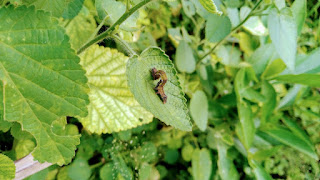terror elsewhere. In 2016 it reached Africa, and in 2018 it reached Asia. In both areas, it has set upon maize plants (its preferred food) and other essential food crops with devastating results. The effect that the Fall Armyworm has had in the developing world has been compounded by its resistance to chemical pesticides and its ability to survive in harsh conditions. In just one year (2018) in Nigeria, these pests disrupted the food supply of 1.5 million people. Faced with such a serious problem, scientists have been working overtime trying to find a solution and it looks like they may be on to something. Parasitoid wasps native to East Africa and India have been identified and, they enthusiastically prey on the non-native armyworm eggs. Here is a great article that will tell you more on this. Suffice to say, these wasps provide a speck a hope in a tragic situation. Fall Armyworms are not just resistant to pesticides and drought, they are efficient and relentless. In fact, they got their name from how they march across fields laying waste to everything in their path, just like an army does. They can devastate a golf course in 48 hours and can wipe out a forage crop in hours. According to this article from Texas A&M, the Fall Armyworm moths can lay up to 2,000 eggs which will hatch out hungry caterpillars in two to three days. Their reproductive cycle is fast enough for at least four to five generations to appear in just one growing season. Although Fall Armyworms are a formidable foe for growers everywhere, there are some steps that can be taken to gain a measure of control. However, if you have an infestation that is well entrenched already, you may have to scrap the lawn or garden for this season and start over next year. Otherwise, your best bet for control will always be a multi-pronged approach. The following are some examples of things to use that can get you the help you need. Our Fall Armyworm page has many more suggestions.
Traps and Lures:
It’s always best to stop an infestation before it starts. With this Scentry Lure, the moths will come right to you and you can monitor how many there are flying about before they turn into ravenous worms (you’ll use it with a Scentry Wing Trap). This will help you plan your next stage of defense. Plus, whatever moths you catch will not be reproducing.
Bacillus thuringiensis:Insecticides:
While Fall Armyworms have displayed resistance to conventional insecticides, this is not generally a concern if you use products whose active ingredients are naturally occurring or botanical. These types of products have modes of actions (suffocation, anti-feeding, etc.) that insects cannot develop resistance to. You may want to try Debug® Optimo, Debug® ON or Debug® Trés, all of which use azadirachtin derived from neem seeds. Or there is Entrust™ SC Naturalyte® Insect Control, whose active ingredient is the soil bacterium spinosad. And then there is PFR-97™ 20% WDG which utilizes the entomopathogenic fungus Isaria fumosorosea Apopka Strain 97. All of these are excellent choices.Fall Armyworms will continue to be a problem until we as a species can get a handle on climate change. In the meantime, with a little foresight you can reduce the effects these pests can have on your growing things.
Take Care.
Submitted by Pam.













No comments:
Post a Comment